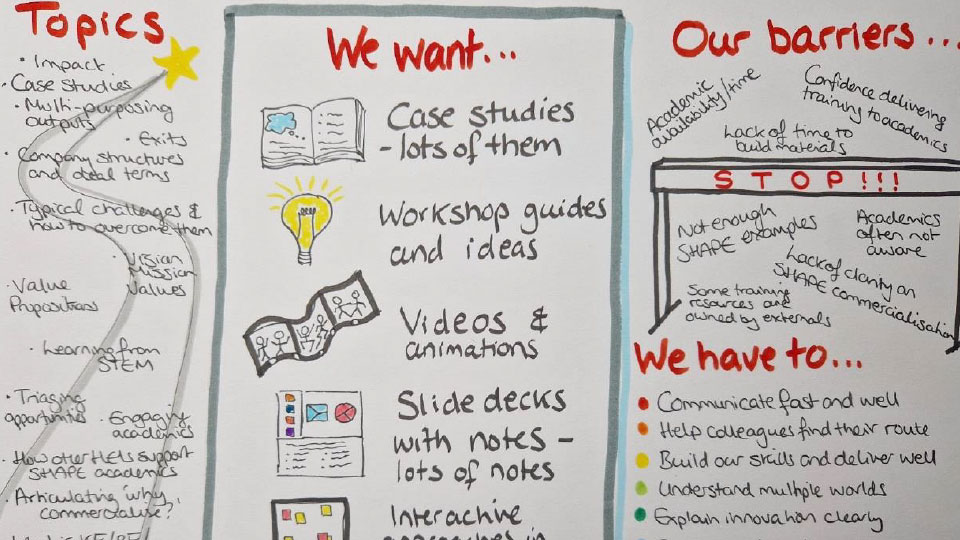
Researchers in the social sciences and humanities are playing key roles in developing creative, collaborative methodologies for developing our understandings of range of social, political, and environmental phenomena. But methods are not only important in witnessing global challenges or as tools to gather data. As we argue in a recent paper in Geo: Geography and Environment, methods themselves can play a role in transforming ideas, practices and knowledge.
Methods for Change is an Aspect funded project running in two phases from 2020-23, which seeks to highlight the value of social science methodologies to the wider world. The project collates innovative and transformative methods and demonstrates how they can create change in a variety of non-academic contexts, including: household consumption practices, infrastructures, waste, health and wellbeing, food, cities and sustainable cities, economic change, gender, age, race and ethnicity.
Bringing together academic contributors who utilise innovative methods within industry and business, third sector, activism and policy sectors, Methods for Change has so far involved experimenting with jargon-free written how-to guides and a range of creative audio-visual materials (films, games, artworks) and events to communicate the potential of social science methodologies to diverse audiences. To create the how-to guides and creative pieces, we interviewed and wrote collaboratively with thirty-six academics from UK institutions, spanning a range of career stages and disciplines human geography, sociology, anthropology, planning, architecture, education, cultural studies, social history, business) to explore the methodological elements of their research. Profiled methods include ‘Follow the Thing’, ‘Systems Origami’, ‘Mobile Phone Methods’, ‘Multi-method Mapping’ and many more.

In our paper, we argue that academics need to articulate why methods matter in creating change to global challenges. Reflecting on our experiences with Phase 1 (2020-21) of Methods for Change, we share three creative techniques – how-to instructions, objects and animal metaphors – that can encourage playful, reflective conversation about methods and their role in galvanising change. These techniques are readily incorporated into semi-structured and online interviews as well as group discussions, and do not require any special equipment or training.

Geography, which is where we are situated as researchers in the Methods for Change team, has become a vibrant space for innovation and debate about method. Shaped in part by the cultural turn and interest in everyday life, lived experience and difference, the past decade has seen numerous books, special issues and articles dedicated to creative, ludic, sensory, non-representational, participatory, mundane, and gentle methods. But despite growing interest in creative methods, interviews or ‘talking’ methods often remain the default. What’s more, much reporting of geographical research has ‘pushed method to the margins’, leading some to call for a more detailed reflection on the mundane doing of method in practice, particularly in relation to interview or ‘talking’ methods.
Drawing on online interviews carried out with researchers from the Methods for Change network, in our paper we considered the process of talking about methods, looking closely at the ways academics spoke about their methods’ role in creating change, and highlighting both challenges and opportunities in communicating transformative potential. We also aimed to reflect candidly on our experiences of doing talking methods, by unpicking some of the messy details of carrying out creative online interviews.

Creative techniques can be particularly useful when talking about how to do method. First, we asked participants to describe the how-to process of their method, as though they were guiding someone unfamiliar with their approach, step-by-step. Next, building on object elicitation methods, we asked interviewees to select an object they could use to talk about their method. This relatively open prompt encouraged participants to reflect playfully on their approach, while centring the method, rather than the research problem or findings. Inspired by research on mortgage consumption and Sarah Butler’s short stories about Manchester’s devolution we then drew on metaphorical thinking, asking ‘if your method were an animal, what would it be?’.

These creative talking techniques enabled researchers to consider their own work from novel vantage points, but they also occasionally resulted in moments of awkwardness. How-to instructions were perhaps the most contentious of the three techniques. Describing a method step-by-step often felt uncomfortable for respondents and interviewers alike, as artificially imposing order onto the messiness of research in practice. However, moments of silence, hesitancy and expressed discomfort allowed us to generate deeper understanding of participants’ decision-making processes and feelings about methods.

Introducing material and metaphorical objects enabled respondents to reveal details that may otherwise have been overlooked or unspoken. Objects often functioned as a third party in the interview, allowing participants to deviate and to consider how methods worked to develop new connections, relationships, and appreciations.

Objects discussed included the material items handled in the process of research (post-its, notepads, mobile phones) as well as mundane objects less immediately associated with data collection but deemed crucial for fieldwork: the boots worn by one researcher using mobile methods; the cushion, essential for another’s comfort during intensive and active listening. Some participants described an object from memory, while many selected something physically ‘close-at-hand’. The object also worked as a deflecting device, something participants could (sometimes literally) hide behind if they found the question difficult.

Thinking through animals draws attention to the embodied dimensions of methods. For example, the practical and hands-on dimensions of arts-based methods were compared with an octopus – its ‘many arms’ combined with the cognitive function required in coordinating the often complex, multifaceted, chaotic nature of research in practice. Animal metaphors also shed light on how researchers imagined method as a process of interacting with materials, environments or data to create new configurations. For example, a spider drawing multiple elements into a complex web as a workshopping method, or earthworms working together to prepare the ground for new growth as participatory research.




Through these techniques, methods are shown as more than simply tools to extract information, but as acting into the world, shaping and transforming it.
In our work with Methods for Change we found creative talking techniques can help academics understand their own methods in more depth, and to communicate how those methods can create change on global socio-environmental, political, and economic challenges. In 2022 to 2023 Methods for Change continued to engage with academics in the Aspect Network about their methods, exploring spatial, mixed methods and quantitative methods in more detail, and aiming to understand where they are used critically and within interdisciplinary or transdisciplinary collaborations. New methods added in Phase 2[LP1] include ‘Collage as Method’, ‘Making Textiles Together’, ‘Militant Research’, ‘Designs for Addressing Racial in Equalities (DARE)’ and many more. You can read about all the methods we have profiled across phases 1 and 2 of Methods for Change in the project in the Research Methods Library, and they are also available to download in an e-book.
We have also developed the animal question – ‘If your research method were an animal, what would it be?’ – into a creative workshop tool aimed at eliciting discussion and self-reflection about the methods we each use as researchers. The ‘Methods Zoo’ workshop has already been piloted with interdisciplinary research teams in Manchester, Newcastle and Sheffield. It will be available as an open access short course aimed at facilitators who would like to run their own creative methods-focused workshop in early 2024 – watch this space!

But for now, we would like to invite readers to reflect on how their own methods might create or contribute to change. How would you guide someone, step by step, through a method used in your own work, and would you feel uncomfortable doing this? Is there an object that helps explain why this method matters? And lastly, if your method were an animal, what would it be?
Further reading:
Hitchings, R., & Latham, A. (2021). Qualitative methods III: On different ways of describing our work. Progress in Human Geography, 45(2), 394-403. https://journals.sagepub.com/doi/full/10.1177/0309132520901753
Latham, A. (2020). Thinking with method: qualitative research in human geography. Area, 52(4), 666-667. https://rgs-ibg.onlinelibrary.wiley.com/doi/full/10.1111/area.12673
Pottinger, L., Phinney, S., Hall, S. M., Browne, A. L., & Barron, A. (2021). Methods for change: Showcasing innovative social science methodologies. Final Report 2020-2021. Aspect and The University of Manchester. https://aspect.ac.uk/resources/methods-for-change-showcasing-innovative-social-science-methodologies/
Methods for Change: Research Methods Library (2024) Aspect. https://aspect.ac.uk/about/aspect-funded-projects/methods-for-change/methods-for-change-research-methodologies/
Bios:
Dr Laura Pottinger is a Simon Research Fellow in Human Geography at The University of Manchester.
Dr Amy Barron is a Lecturer in Social and Cultural Geography at The University of Manchester.
Dr Sarah Marie Hall is Professor of Human Geography at The University of Manchester, and her interests lie in feminist economic geographies of everyday life.
Dr Ali Browne is Professor of Human Geography at The University of Manchester, and with Dr Sarah M. Hall is co-PI of the Methods for Change project, funded by the Aspect Network and Research England.
This blog was originally posted on Geography Directions in April 2022. It has been updated in this version to reflect developments in the Methods for Change project and is accompanied by new illustrations created by Jack Brougham – www.jackbroughamdrawing.com



